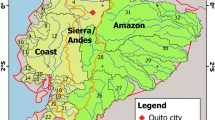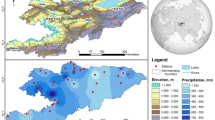Abstract
Taking 5 m grid resolution DEMs of 48 test areas in the Loess Plateau in northern Shaanxi as test data, this paper introduces a new terrain factor of soil erosion at regional scale, i.e. G. Results show that spatial distribution of G is related to the spatial distribution of the soil erosion intensity and G can be taken as a terrain factor of regional soil erosion in the Loess Plateau. Comparison analysis between G and LS shows G is more capable of playing the role as a regional terrain factor of soil erosion than that of LS, at least in the Loess Plateau. But G is not exact enough in evaluation processing of regional soil erosion, an integrated analysis combining the climate, vegetation cover, soil and water conservation management is demanded. For lack of measurement data at corresponding test area, quantitative analysis of correlation between G and soil erosion modulus is not reality. But based on a regional soil erosion model, a qualitative soil erosion intensity map is designed based on an overlaying calculation of G, vegetation cover, rainfall erosivity and soil antierodibility.
Access this chapter
Tax calculation will be finalised at checkout
Purchases are for personal use only
Preview
Unable to display preview. Download preview PDF.
Similar content being viewed by others
References
Chang MD, Zhao GY and Tian AM (1996) Rural economic development and comprehensivecontrol of small watershed on the loess Plateau. RES of SOIL WAT, 3(4): 88-92 (in Chinese)
Chris SR and Jon H (2002) Soil erosion assessment tools from point to regional scales-the role ofgeomorphologists in land management research and implementation. GEOMORPHOLO, 47:189-209
Cui Y, Li R and Yang QK (2006) Preliminary research on the patterns of regional soil erosion inview of GIS. J of Xi’an university of ART & S (natural science edition), 9(2): 5-8 (in Chinese)
De JSM, Paracchini ML, Bertolo F et al (1999) Regional assessment of soil erosion using thedistributed model SEMMED and remotely sensed data. CATENA, 37(3-4): 291-308
Endre D, Luca M, Thierry N et al (2001) A regional scale soil mapping approach using intergratedAVHRR and DEM data. JAG, 3(1): 30-42
Favis-Mortlock D, Guerra T and Boardman J (1998) A self-organizing systems approach to hillsloprill initiation and growth: model development and validation. IAHS publication, 249: 53-61
Geoef P and Alan M (2001) Regional-scale sedimentation process models from airborne gammaray remote sensing and digital elevation data. EARTH SURF, 26: 273–293
Groundwater P (2000) The influence of model resolution on rill development: A numerical modelingstudy. HYDROL PROC, 14(6): 2173-2205http://www.geog.ntu.edu.tw/main/paper/R89228006/abstract.htm. Accessed 15 July 2010http://www.itc.nl/personal/shrestha/DTA/terrain_par.htm. Accessed 11 June 2010
Jiang DS (1997) Pattern of soil erosion and management of the loess plateau. China WaterPowerPress, Beijing (in Chinese)
Jiang ZS, Wang ZQ and Liu Z (1996) Quantitative study on spatial variation of soil erosion in asmall watershed in the Loess Hilly Region. J of soil erosion and soil conservation, 2(1): 1-9
Jiang ZS, Zheng FL, Wu M (2005) Prediction model of water erosion on hillslopes. J of SedimentResearch, (4): 1-6
Li FY and Tang GA (2006) DEM based research on the terrain driving force of soil erosion in theLoess Plateau. in Geoinformatics 2006: Geospatial Information Science, edited by JianyaGong, Jingxiong Zhang, Proc. of SPIE Vol. 6420, 64201W
Li R, Yang WZ, Li BC (2008) Research and future prospects for the loess plateau of China. SciencePress, Beijing (in Chinese)
Liu BY, Nearing MA Shi PJ et al (2000) Slope length effects on soil loss for steep slopes. SoilSoc Am J, 64 (5): 1759-1763
Liu BY, Xie Y and Zhang KL (2001) Soil erosion prediction model. Chinese Science and Technologypublishing house, Beijing (in Chinese)
Mou JZ and Meng QM (1983) Preliminary research on prediction of rainfall soil loss. ChinaSOIL WAT, (6): 23 - 27 (in Chinese)
Richard JP (2000) Geomorphometry – diversity in quantitative surface analysis. PROG P GEO,24(1):1-30
Shi H and Shao MG (2000) Soil and water loss from the Loess Plateau in China. J ARID ENV,45: 9-20.
Sidorchuk A (1999) Dynamic and static models of gully erosion. CATENA, 37(3-4): 401-414
Tang GA (2003) Slope Spectrum of the Loess Plateau and Its Spatial Distribution. Proceedings of2003 annual meeting of the geographical society of China, Wuhan (in Chinese)
Tang GA (2000) A research on the accuracy of digital elevation models. Science Press, Beijing
Wang L, Tang GA, Liu XJ et al (2004) Terrain Complexity Index and Derivation of based onDEMs. Bulletin of SOIL WAT, 24(4): 55-58 (in Chinese)
Wang WZ and Jiao JY (1996) Rainfall erosion of the loess plateau and sand transportation in yellowriver. Science Press, Beijing (in Chinese)
Woodward DE (1999) Method to predict cropland ephemeral gully erosion. CATENA, 37(2):393-399
Xu TC, Gao RL and Wang DX (1994) Development and experimences of soil and water conservationon the Loess Plateau since the eighties. Bulletin of SOIL WAT, 14(4): 12-18 (in Chinese)
Yin GK and Chen QL (1989) Characteristic index and statistical model of sediment yield insmall drainage basins of Loess Plateau in China. Acta Geographica Sinica, 44(1): 32-45 (inChinese)
Zhou Q and Liu XJ (2006) Digital terrain analysis. Science Press, Beijing (in Chinese)
Author information
Authors and Affiliations
Corresponding author
Editor information
Editors and Affiliations
Rights and permissions
Copyright information
© 2011 Springer-Verlag Berlin Heidelberg
About this paper
Cite this paper
Li, F., Tang, G. (2011). DEM based Terrain Factor of Soil Erosion at regional Scale and Soil Erosion Mapping. In: Ruas, A. (eds) Advances in Cartography and GIScience. Volume 2. Lecture Notes in Geoinformation and Cartography(), vol 6. Springer, Berlin, Heidelberg. https://doi.org/10.1007/978-3-642-19214-2_26
Download citation
DOI: https://doi.org/10.1007/978-3-642-19214-2_26
Published:
Publisher Name: Springer, Berlin, Heidelberg
Print ISBN: 978-3-642-19213-5
Online ISBN: 978-3-642-19214-2
eBook Packages: Earth and Environmental ScienceEarth and Environmental Science (R0)




